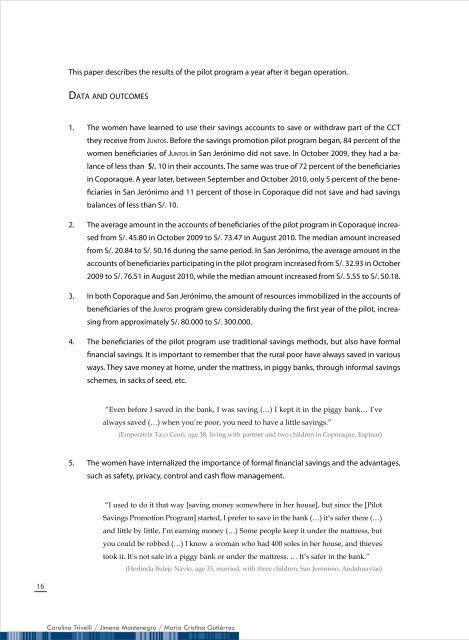unanoahorrando
unanoahorrando
unanoahorrando
You also want an ePaper? Increase the reach of your titles
YUMPU automatically turns print PDFs into web optimized ePapers that Google loves.
16<br />
This paper describes the results of the pilot program a year after it began operation.<br />
data and outComes<br />
1. The women have learned to use their savings accounts to save or withdraw part of the CCT<br />
they receive from Juntos. Before the savings promotion pilot program began, 84 percent of the<br />
women beneficiaries of Juntos in San Jerónimo did not save. In October 2009, they had a balance<br />
of less than S/. 10 in their accounts. The same was true of 72 percent of the beneficiaries<br />
in Coporaque. A year later, between September and October 2010, only 5 percent of the beneficiaries<br />
in San Jerónimo and 11 percent of those in Coporaque did not save and had savings<br />
balances of less than S/. 10.<br />
2. The average amount in the accounts of beneficiaries of the pilot program in Coporaque increased<br />
from S/. 45.80 in October 2009 to S/. 73.47 in August 2010. The median amount increased<br />
from S/. 20.84 to S/. 50.16 during the same period. In San Jerónimo, the average amount in the<br />
accounts of beneficiaries participating in the pilot program increased from S/. 32.93 in October<br />
2009 to S/. 76.51 in August 2010, while the median amount increased from S/. 5.55 to S/. 50.18.<br />
3. In both Coporaque and San Jerónimo, the amount of resources immobilized in the accounts of<br />
beneficiaries of the Juntos program grew considerably during the first year of the pilot, increasing<br />
from approximately S/. 80.000 to S/. 300.000.<br />
4. The beneficiaries of the pilot program use traditional savings methods, but also have formal<br />
financial savings. It is important to remember that the rural poor have always saved in various<br />
ways. They save money at home, under the mattress, in piggy banks, through informal savings<br />
schemes, in sacks of seed, etc.<br />
“Even before I saved in the bank, I was saving (…) I kept it in the piggy bank… I’ve<br />
always saved (…) when you’re poor, you need to have a little savings.”<br />
(Emperatriz Taco Ccori, age 38, living with partner and two children in Coporaque, Espinar)<br />
5. The women have internalized the importance of formal financial savings and the advantages,<br />
such as safety, privacy, control and cash flow management.<br />
“I used to do it that way [saving money somewhere in her house], but since the [Pilot<br />
Savings Promotion Program] started, I prefer to save in the bank (…) it’s safer there (…)<br />
and little by little, I’m earning money (…) Some people keep it under the mattress, but<br />
you could be robbed (…) I know a woman who had 400 soles in her house, and thieves<br />
took it. It’s not safe in a piggy bank or under the mattress. … It’s safer in the bank.”<br />
(Herlinda Buleje Navio, age 33, married, with three children, San Jerónimo, Andahuaylas)<br />
Carolina Trivelli / Jimena Montenegro / María Cristina Gutiérrez


